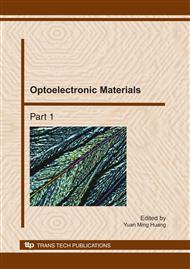p.100
p.104
p.108
p.113
p.118
p.125
p.129
p.133
p.137
Controllable Luminescent Properties of Phosphors Sr2.97-XCaxMgSi2O8: Eu0.012+, Dy0.023+ by Adjusting Sr/Ca Ratio
Abstract:
Divalent europium and trivalent dysprosium co-doping in the compounds Sr2.97-xCaxMgSi2O8 (x=0, 0.5, 1.5, 2, 2.5, 2.97) produces phosphors of high luminescence yield. These phosphors were prepared at high temperature and weak reductive atmosphere. The ratio of Eu/Dy is 1/2. The phosphors were characterized for their crystal phases by x-ray powder diffraction. Slight shifts of the peaks in the structure, which indicate a small change of the interplanar crystal spacing, were observed for each different x’s. The interplanar spacing becomes narrow as increasing the value of x. These phosphors respond well to the ultraviolet excitation. The peak of the emission band occurs at progressively longer wavelength and widens as the ratio of alkaline earth Sr/Ca ions is decreased. The emission peaks of the phosphors indicated on the emission spectra range from 463nm to 490nm. It is probably due to the influence of 5d electron states of Eu2+ in the crystal field because of atomic size variation causing crystal defects. Dy3+ ion doping in the phosphor generates deep traps, which results in long afterglow phosphorescence. As the proportion of Ca in the composition increases, the attenuation time of the phosphors becomes short.
Info:
Periodical:
Pages:
118-124
Citation:
Online since:
November 2010
Authors:
Price:
Сopyright:
© 2011 Trans Tech Publications Ltd. All Rights Reserved
Share:
Citation:


